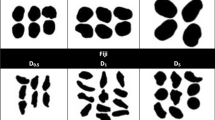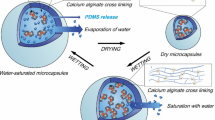Abstract
Purpose
Compression studies can provide insights into evaluating the engineering potential and environmental impact of clay. The objective of this study was to quantitatively investigate the bound water characteristics and microstructure evolution during uniaxial compression of mucky silty clay and to explore the effects of structure, loading, and time on the secondary compression.
Materials and methods
An integrated approach was developed to investigate the macro compression characteristics of Qingdao clay and the evolution of pore water and microstructure during compression using uniaxial confined compression tests involving multi-stage and separate loading, thermogravimetric analysis (TGA), and scanning electron microscopy (SEM).
Results and discussion
The secondary compression coefficient (Cα) increases with the vertical stress (\({\sigma }_{v}^{^{\prime}}\)) to a peak and slowly decreases above the yield stress (\({\sigma }_{vy}^{^{\prime}}\)). The value of Cα decreases with time. The expulsion of free water occurs for \({\sigma }_{v}^{^{\prime}}<{\sigma }_{vy}^{^{\prime}}\) corresponding to a change in the trellis pores, whereas the extraction of weakly bound water begins when \({\sigma }_{v}^{^{\prime}}>{\sigma }_{vy}^{^{\prime}}\), accompanied by the increased fineness and regularity of intergranular pores. The microstructure changes from a loose skeleton-flocculate to a compact agglomerate structure as the vertical stress increases. The apparent area proportions increase with the vertical stress for pores with equivalent diameters (d) < 1 μm, d = 1 ~ 2 μm, and d = 2 ~ 5 μm; however, both the number and apparent area proportion decrease for the trellis pores with d = 5 ~ 10 μm. A four-tiered, three-stage conceptual microstructure model is established to elucidate the compression mechanism.
Conclusions
Structural collapse and the expulsion of weakly bound water produce a peak in Cα. The finiteness of particle dislocation and the change of bound water film lead to a decrease in Cα with the vertical stress and time.










Similar content being viewed by others
References
Bayat H, Ebrahimi E, Fallah M (2018) Estimation of soil moisture using confined compression curve parameters. Geoderma 318:64–77
Bowman ET, Soga K (2003) Creep, ageing and microstructural change in dense granular materials. Soils Found 43(4):107–117
Burland JB (1990) On the compressibility and shear strength of natural clays. Geotechnique 40(3):329–378
Butterfield R (1979) A natural compression law for soils (an advance on e-logp’). Geotechnique 29(4):469–480
Cai Y, Shi B, Ng CWW, Tang C (2006) Effect of polypropylene fiber and lime admixture on engineering properties of clayey soil. Eng Geol 87:230–240
China, (1999) Standard for soil test methods (GB/T 50123–1999). China Planning Press, Beijing
Deng YF, Cui YJ, Tang AM, Li XL, Sillen X (2012) An experimental study on the secondary deformation of Boom clay. Appl Clay Sci 59–60:19–25
Du YJ, Jiang NJ, Liu SY, Jin F, Singh DN, Puppala AJ (2013) Engineering properties and microstructural characteristics of cement-stabilized zinc-contaminated kaolin. Can Geotech J 51(3):289–302
EN 933–9: 2009 (2009) Tests for geometrical properties of aggregates–part 9: assessment of fines–methylene blue test
Fernández AM, Sánchez-Ledesma DM, Tournassat C, Melón A, Gaucher EC, Astudillo J, Vinsot A (2014) Applying the squeezing technique to highly consolidated clayrocks for pore water characterisation: lessons learned from experiments at the Mont Terri Rock Laboratory. Appl Geochem 49:2–21
Gratchev I, Towhata I (2016) Compressibility of soils containing kaolinite in acidic environments. KSCE J Civ Eng 20(2):623–630
Gu K, Shi B, Liu C, Jiang H, Li T, Wu J (2018) Investigation of land subsidence with the combination of distributed fiber optic sensing techniques and microstructure analysis of soils. Eng Geol 240:34–47
Han Z, Vanapalli SK (2017) Normalizing variation of stiffness and shear strength of compacted fine-grained soils with moisture content. J Geotech Geoenviron Eng 143(9):04017058
Handy RL (2002) First-order rate equations in geotechnical engineering. J Geotech Geoenviron Eng 128(5):416–425
Haruo F, Shunji U, Kazuya Y (1987) Secondary compression of clay under repeated loading. Soils Found 27:21–30
Hong ZS, Zeng LL, Cui YJ, Cai YQ, Lin C (2012) Compression behaviour of natural and reconstituted clays. Geotechnique 62(4):291–301
Jia R, Lei HY, Li K (2020) Compressibility and microstructure evolution of different reconstituted clays during 1D compression. Int J Geomech 20(10):04020181
JY, T 010–1996 (1996) General rules for analytical scanning electron microscopy Scientific and Technical Documentation Press Beijing
Karsanina MV, Gerke KM, Skvortsova EB, Ivanov AL, Mallants D (2018) Enhancing image resolution of soils by stochastic multiscale image fusion. Geoderma 314:138–145
Keller T, Lamandé M, Schjønning P, Dexter AR (2011) Analysis of soil compression curves from uniaxial confined compression tests. Geoderma 163:13–23
Kucerik J, Tokarski D, Demyan MS, Merbach I, Siewert C (2018) Linking soil organic matter thermal stability with contents of clay, bound water, organic carbon and nitrogen. Geoderma 316:38–46
Kuligiewicz A, Derkowski A (2017) Tightly bound water in smectites. Am Mineral 102(5):1073–1090
Leroueil S, Vaughan PR (1990) The general and congruent effects of structure in natural soils and weak rocks. Geotechnique 40:467–488
Li SL, Bo ZZ (1982) Translation collection of adsorbed water in soil. Geological Publishing House, Beijing
Li YL, Wang TH, Su LJ (2015) Determination of bound water content of loess soils by isothermal adsorption and thermogravimetric analysis. Soil Sci 180(3):90–96
Li S, Wang CM, Zhang XW, Zou LL, Dai ZX (2019) Classification and characterization of bound water in marine mucky silty clay. J Soils Sediments 19(5):2509–2519
Li P, Shao SJ, Vanapalli SK (2020) Characterizing and modeling the pore-size distribution evolution of a compacted loess during consolidation and shearing. J Soils Sediments 20:2855–2867
Liang FL, Sauceau M, Dusserre G, Dirion J-L, Arlabosse P (2018) Modelling of the rheological behavior of mechanically dewatered sewage sludge in uniaxial cyclic compression. Water Res 147:413–421
Liu H, Liu P, Hu H, Zhang Q, Wu Z, Yang J, Yao H (2014) Combined effects of Fenton peroxidation and CaO conditioning on sewage sludge thermal drying. Chemosphere 117:559–566
Liu Z, Liu F, Ma F, Wang M, Bai X, Zheng Y, Yin H, Zhang G (2016) Collapsibility, composition, and microstructure of loess in China. Can Geotech J 53(4):673–686
Maček M, Mauko A, Mladenovič A, Majes B, Petkovšek A (2013) A comparison of methods used to characterize the soil specific surface area of clays. Appl Clay Sci 83–84:144–152
Marcial D, Delage P, Yu JC (2002) On the high stress compression of bentonites. Can Geotech J 39(4):812–820
Mesri G, Vardhanabhuti B (2005) Secondary Compression J Geotech Geoenviron Eng 131:398–401
Mesri G, Ajlouni M (2007) Engineering properties of fibrous peats. J Geotech Geoenviron Eng 133:850–866
Mitchell JK, Soga K (2005) Fundamentals of soil behavior, 3rd edn. John Wiley and Sons Inc, New York
Morin R, Silva AJ (1984) The effects of high pressure and high temperature on some physical properties of ocean sediments. J Geophys Res Solid Earth 89(B1):511–526
Murad MA, Guerreiro JN, Loula AFD (2001) Micromechanical computational modelling of secondary consolidation and hereditary creep in soils. Comput Methods Appl Mech Eng 190:1985–2016
Musso TB, Parolo ME, Pettinari G, Francisca FM (2014) Cu(II) and Zn(II) adsorption capacity of three different clay liner materials. J Environ Manag 146:50–58
Quigley RM, Ogunbadejo TA (1972) Clay layer fabric and oedometer consolidation of a soft varved clay. Can Geotech J 9:165–175
Reichert JM, Mentges MI, Rodrigues MF, Cavalli JP, Awe GO, Mentges LR (2018) Compressibility and elasticity of subtropical no-till soils varying in granulometry organic matter, bulk density and moisture. CATENA 165:345–357
Schäffer B, Boivin P, Schulin R (2010) Compressibility of repacked soil as affected by wetting and drying between uniaxial compression tests. Soil Sci Soc Am J 74:1483–1492
Shahriar AR, Jadid R (2018) An experimental investigation on the effect of thixotropic aging on primary and secondary compression of reconstituted dredged clays. Appl Clay Sci 162:524–533
Sposito G, Prost R (1982) Structure of water adsorbed on smectites. Chem Rev 82(6):553–573
Tonni L, García Martínez MF, Simonini P, Gottardi G (2016) Piezocone-based prediction of secondary compression settlements of coastal defence structures on natural silt mixtures. Ocean Eng 116:101–116
Wang Y, Lu S, Ren T, Li BG (2011) Bound water content of air-dry soils measured by thermal analysis. Soil Sci Soc Am J 75(2):481–487
Wang D, Abriak NE (2015) Compressibility behavior of Dunkirk marine structured and reconstituted soils. Mar Georesour Geotechnol 33(5):419–428
Wang HD, She DL, Fei YH, Tang SQ (2019a) Synergic effects of biochar and polyacrylamide amendments on the mechanical properties of silt loam soil under coastal reclamation in China. Catena 182:104152
Wang JD, Li P, Ma Y, Vanapalli SK (2019b) Evolution of pore-size distribution of intact loess and compacted loess due to consolidation. J Soils Sediments 19(3):1226–1238
Wang YH, Xu D (2007) Dual porosity and secondary consolidation. J Geotech Geoenviron Eng 133:793–801
Wei J, Shi B, Li J, Li S, He X (2018) Shear strength of purple soil bunds under different soil water contents and dry densities: a case study in the Three Gorges reservoir area, China. CATENA 166:124–133
Wong RCK, Varatharajan S (2014) Viscous behaviour of clays in one-dimensional compression. Can Geotech J 51(7):795–809
Wong JTF, Chen Z, Chen X, Ng CWW, Wong MH (2017) Soil-water retention behavior of compacted biochar-amended clay: a novel landfill final cover material. J Soils Sediments 17(3):590–598
Wu FC (1984) Measurement of adsorbed bound water in clay soils and some characteristics of seepage. Chin J Geotech Eng 6(6):84–93
Ye C, Guo ZL, Cai CF, Wang JG, Deng J (2017) Effect of water content, bulk density, and aggregate size on mechanical characteristics of Aquults soil blocks and aggregates from subtropical China. J Soils Sediments 17(1):210–219
Yen PS, Lee DJ (2001) Errors in bound water measurements using centrifugal setting method. Water Res 35(16):4004–4009
Yuan ZX, Wang LM (2009) Collapsibility and seismic settlement of loess. Eng Geol 105:119–123
Yuan YJ, Rezaee R, Verrall M, Hu S-Y, Zou J, Testmanti N (2018) Pore characterization and clay bound water assessment in shale with a combination of NMR and low-pressure nitrogen gas adsorption. Int J Coal Geol 194:11–21
Zentar R, Dubois V, Abriak NE (2008) Mechanical behaviour and environmental impacts of a test road built with marine dredged sediments. Resour Conserv Recycl 52:947–954
Zhang T, Cai GJ, Liu SY (2018) Application of lignin-stabilized silty soil in highway subgrade: A macroscale laboratory study. J Mater Civ Eng 30(4):04018034
Zhang T, Yang YL, Liu SY (2020) Application of biomass by-product lignin stabilized soils as sustainable geomaterials: a review. Sci Total Environ 728:138830
Zhang ZL, Cui ZD (2017) Analysis of microscopic pore structures of the silty clay before and after freezing–thawing under the subway vibration loading. Environ Earth Sci 76(15):528
Zhu Z, Liu S (2008) Utilization of a new soil stabilizer for silt subgrade. Eng Geol 97:192–198
Funding
This work was supported by the Natural Science Foundations of China (Grant No. 41572257; 41972267).
Author information
Authors and Affiliations
Corresponding authors
Ethics declarations
Conflict of interest
The authors declare no competing interests.
Additional information
Responsible editor: Jianming Xue
Publisher's Note
Springer Nature remains neutral with regard to jurisdictional claims in published maps and institutional affiliations.
Rights and permissions
About this article
Cite this article
Li, S., Wang, C., Zhang, S. et al. Bound water characteristics and microstructure evolution during uniaxial compression of mucky silty clay. J Soils Sediments 22, 782–796 (2022). https://doi.org/10.1007/s11368-021-03102-x
Received:
Accepted:
Published:
Issue Date:
DOI: https://doi.org/10.1007/s11368-021-03102-x




